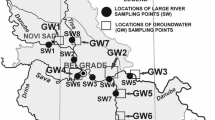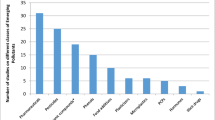Abstract
Exposure of active pharmaceutical compounds (APCs) to the environment during human use is of potential importance in the emergence of drug resistance, changing soil microbiota and their residual effect on living organisms. Thus, this study aimed to assess the extent of exposure of APCs in the hydrologic cycle in and around New Delhi. This study analyzed the presence of 28 drugs from different classes in the surface water (river Yamuna) and aquifers collected from 48 places in Delhi (within the radius of 40 km). The collected water samples were quantified for APCs content using LC-MS/MS. This study revealed that aquifers are extensively affected in most areas based on the accumulation of APCs in water resources to the levels > 0.01 μg/L. Interestingly, a geographical plot of total APCs studied indicated clustering in aquifers with such high levels closer to an unscientific landfill. This 30-year-old un-segregated landfill is found to drain leachate into surface water that had high APCs. This study further revealed that apart from therapeutic usage, the main source of ecological exposure could be due to the disposal of unused and expired pharmaceutical compounds into landfills. For the first time, this study revealed the existence of antimicrobial agents and other APCs in the aquifers of Delhi with levels > 0.1 μg/L, which is a matter of serious concern in terms of multi-drug resistance and other environmental perils. This study warrants the enforcement of regulations for the disposal of unused/expired APCs in high-density population areas.



Similar content being viewed by others
References
Adegoke AA, Faleye AC, Singh G, Stenström TA (2016). Antibiotic resistant superbugs: assessment of the interrelationship of occurrence in clinical settings and environmental niches. Molecules 27;22(1)
Anita KA, Verma AK, Gupta MK, Rahal A (2014) Multidrug resistant pathogenic Escherichia coli status in water sources and river Yamuna in and around Mathura. India Pak J Biol Sci 17(4):540–544
Chen G, Liu X, Tartakevosky D, Li M (2016) Risk assessment of three fluoroquinolone antibiotics in the groundwater recharge system. Ecotoxicol Environ Saf 33:18–24. https://doi.org/10.1016/j.ecoenv.2016.05.030
Cui YF, He JT, Su SH, Yang L, Qiao XC (2015) Distribution characteristics of fluoroquinolones antibiotics in surface water and groundwater from typical areas in a city. Huan Jing Ke Xue 36(11):4060–4067
Cuthbert RJ, Taggart MA, Prakash V, Chakraborty SS, Deori P, Galligan T, Kulkarni M, Ranade S, Saini M, Sharma AK, Shringarpure R, Green RE (2014). Avian scavengers and the threat from veterinary pharmaceuticals. Philos Trans R Soc Lond B Biol Sci ;369(1656). doi: https://doi.org/10.1098/rstb.2013.0574
DeNIS :Investigators of the Delhi Neonatal Infection Study collaboration (2016) Characterisation and antimicrobial resistance of sepsis pathogens in neonates. Born in tertiary care centres in Delhi, India: a cohort study. Lancet. Glob. Health 4(10):e752–e760. https://doi.org/10.1016/S2214-109X(16)30148-6
Devarajan N, Köhler T, Sivalingam P, Van DC, Mulaji CK, Mpiana PT, Ibelings BW, Poté J (2017) Antibiotic resistant Pseudomonas spp. in the aquatic environment: a prevalence study under tropical and temperate climate conditions. Water Res 115:256–265. https://doi.org/10.1016/j.watres.2017.02.058
EMEA, 2006. Guidelines on the environmental risk assessment of medicinal products for human use. Doc/ref/EMA/CHMP/SWP/4447/00
Fick J, Söderström H, Lindberg RH, Phan C, Tysklind M, Larsson DG (2009) Contamination of surface, ground, and drinking water from pharmaceutical production. Environ Toxicol Chem 28(12):2522–2527. https://doi.org/10.1897/09-073.1
File data, 2015. Drugs usage data for the year 2015 expressed in the tender document GMSD/HYD/EQ/2015–16/B/245 accessed from the website https://eprocure.gov.in
Food and Drug Administration, (2001) Guidance for industry: bioanalytical method validation., U.S. Department of Health and Human Services. http://www.labcompliance.de/documents/FDA/FDA-Others/Laboratory/f-507-bioanalytical-4252fnl.pdf
García-Valcárcel AI, Tadeo JL (2011) Determination of azoles in sewage sludge from Spanish wastewater treatment plants by liquid chromatography-tandem mass spectrometry. J Sep Sci 34(11):1228–1235. https://doi.org/10.1002/jssc.201000814
Göttig S, Pfeifer Y, Wichelhaus TA, Zacharowski K, Bingold T, Averhoff B, Brandt C, Kempf VA (2010) Global spread of New Delhi metallo-β-lactamase 1. Lancet Infect Dis 10(12):828–829. https://doi.org/10.1016/S1473-3099(10)70275-9
Kumarasamy KK, Toleman MA, Walsh TR, Bagaria J, Butt FA, Balakrishnan R, Chaudhary U, Doumith M, Giske CG, Irfan S, Krishnan P, Kumar AV, Maharjan S, Mushtaq S, Noorie T, Paterson DL, Pearson A, Perry C, Pike R, Rao B, Ray U, Sarma JB, Sharma M, Sheridan E, Thirunarayan MA, Turton J, Upadhyay S, Warner M, Welfare W, Livermore DM, Woodford N (2010) Emergence of a new antibiotic resistance mechanism in India, Pakistan, and the UK: a molecular, biological, and epidemiological study. Lancet Infect Dis 10:597–602. https://doi.org/10.1016/S1473-3099(10)70143-2
Ma Y, Li M, Wu M, Li Z, Liu X (2015) Occurrences and regional distributions of 20 antibiotics in water bodies during groundwater recharge. Sci Total Environ 518-519:498–506. https://doi.org/10.1016/j.scitotenv.2015.02.100
McEachran AD, Shea D, Bodnar W, Nichols EG (2016) Pharmaceutical occurrence in groundwater and surface waters in forests land-applied with municipal wastewater. Environ Toxicol Chem 35(4):898–905. https://doi.org/10.1002/etc.3216
Mutiyar PK, Mittal AK (2014) Occurrences and fate of selected human antibiotics in influents and effluents of sewage treatment plant and effluent-receiving river Yamuna in Delhi (India). Environ Monit Assess 186(1):541–557. https://doi.org/10.1007/s10661-013-3398-6
O'Donnell MR, Daftary A, Frick M, Hirsch-Moverman Y, Amico KR, Senthilingam M, Wolf A, Metcalfe JZ, Isaakidis P, Davis JL, Zelnick JR, Brust JCM, Naidu N, Garretson M, Bangsberg DR, Padayatchi N, Friedland G (2016) Re-inventing adherence: toward a patient-centered model of care for drug-resistant tuberculosis and HIV. Int J Tuberc Lung Dis 20(4):430–434. https://doi.org/10.5588/ijtld.15.0360
Peng X, Ou S, Wang C, Wang Z, Huang Q, Jin J, Tan J (2014) Occurrence and ecological potential of pharmaceuticals and personal care products in ground water and reservoirs in the vicinity of municipal landfills in China. Sci Total Environ 490:889–898. https://doi.org/10.1016/j.scitotenv.2014.05.068
Rai RK, Upadhyay A, Ojha CSP, Singh VP (2012) The river Yamuna River basin. Water Sci Technol Lib 66:307–356. https://doi.org/10.1007/978-94-007-2001-5
Sharma SK, Jha S (2015) Directly observed treatment is not the only solution for poor adherence and low cure of tuberculosis. Evid Based Med 20(5):180. https://doi.org/10.1136/ebmed-2015-110247
Smit PH, Lymberis A (2015) H2020 EU Research & Innovation Program Boost the transfer of technological breakthroughs, enable new solutions for personalised health and impact the industry and healthcare systems. Stud health Technol Inform 211:3–17
Thummet KE, Shen DD, Isoherranen N (2011) Design and optimization of dosage regiments: pharmacokinetic data (appendix II) in, 12th edn. Goodman & Gillman Pharmacological Basis of therapeutics, McGraw hill, USA, pp 1891–1990
UN WWAP, 2003. United Nations world water assessment Programme. The world water development report 1: water for people, water for life. http://www.unesco.org/new/en/natural-sciences/environment/water/wwap/wwdr/wwdr1-2003/
Yao L, Wang Y, Tong L, Li Y, Deng Y, Guo W, Gan Y (2015) Seasonal variation of antibiotics concentration in the aquatic environment: a case study at Jianghan Plain, central China. Sci Total Environ 527-528:56–64
Yong D, Toleman MA, Giske CG, Cho HS, Sundman K, Lee K, Walsh TR (2009) Characterization of a new Metallo-β-lactamase gene, blaNDM-1, and a novel erythromycin esterase gene carried on a unique genetic structure in Klebsiella pneumoniae sequence type 14 from India. Antimicrob Agents Chemother 53(12):5046–5054. https://doi.org/10.1128/AAC.00774-09
Acknowledgements
We thank the Department of Science and Technology (DST-FIST) program for the provision of LC-MS/MS at High Precision Bio-analytical Laboratory, Dr. RP Center, AIIMS, where the quantifications have been carried out. Use of the Google Fusion Table for reconstructing the geographical map is acknowledged.
Funding
This research did not receive any specific grant from funding agencies in the public, commercial, or not-for-profit sectors.
Author information
Authors and Affiliations
Corresponding author
Ethics declarations
Conflict of interest
The authors declare that they have no conflict of interest.
Additional information
Responsible editor: Ester Heath
Rights and permissions
About this article
Cite this article
Velpandian, T., Halder, N., Nath, M. et al. Un-segregated waste disposal: an alarming threat of antimicrobials in surface and ground water sources in Delhi. Environ Sci Pollut Res 25, 29518–29528 (2018). https://doi.org/10.1007/s11356-018-2927-9
Received:
Accepted:
Published:
Issue Date:
DOI: https://doi.org/10.1007/s11356-018-2927-9




